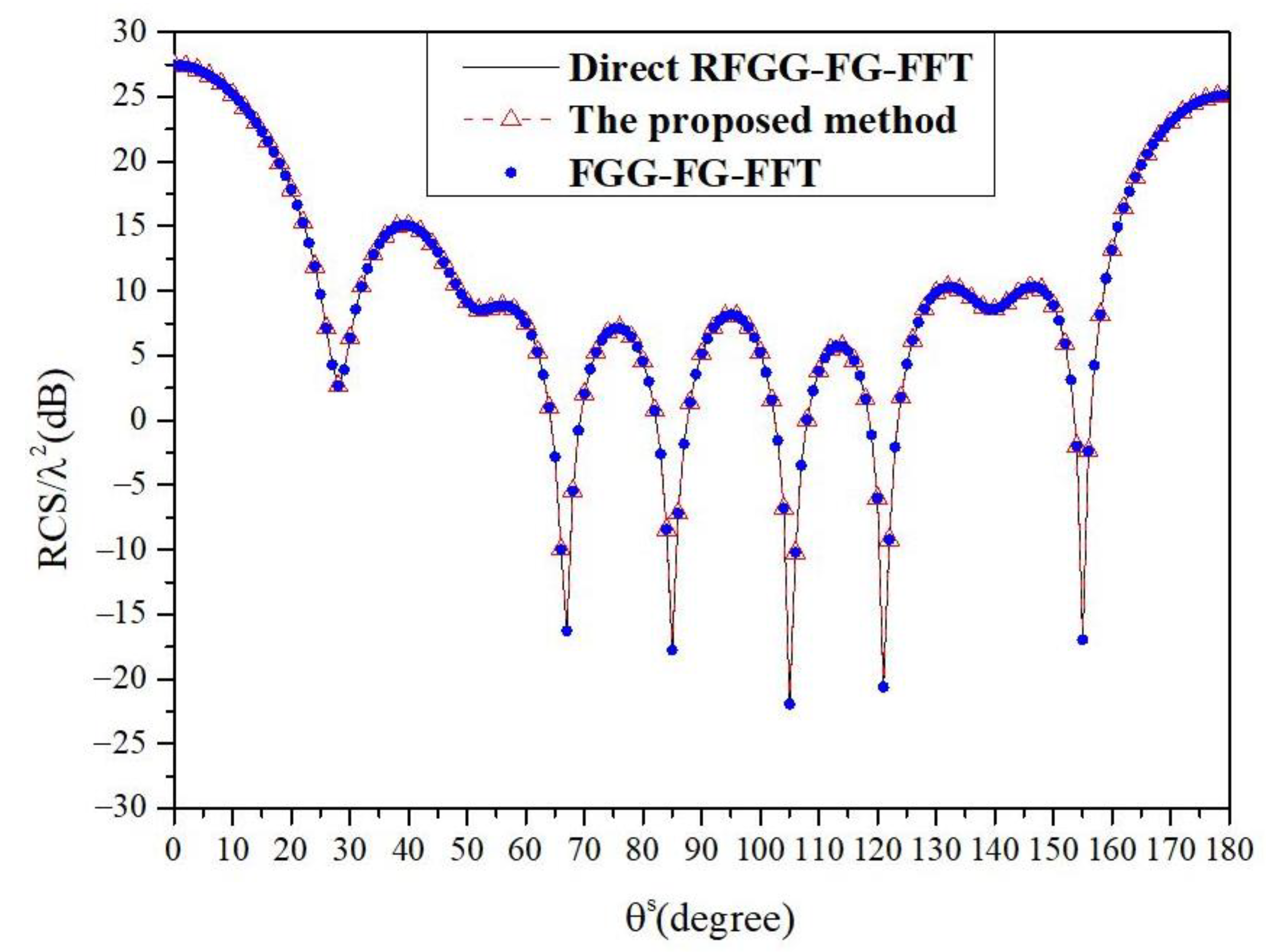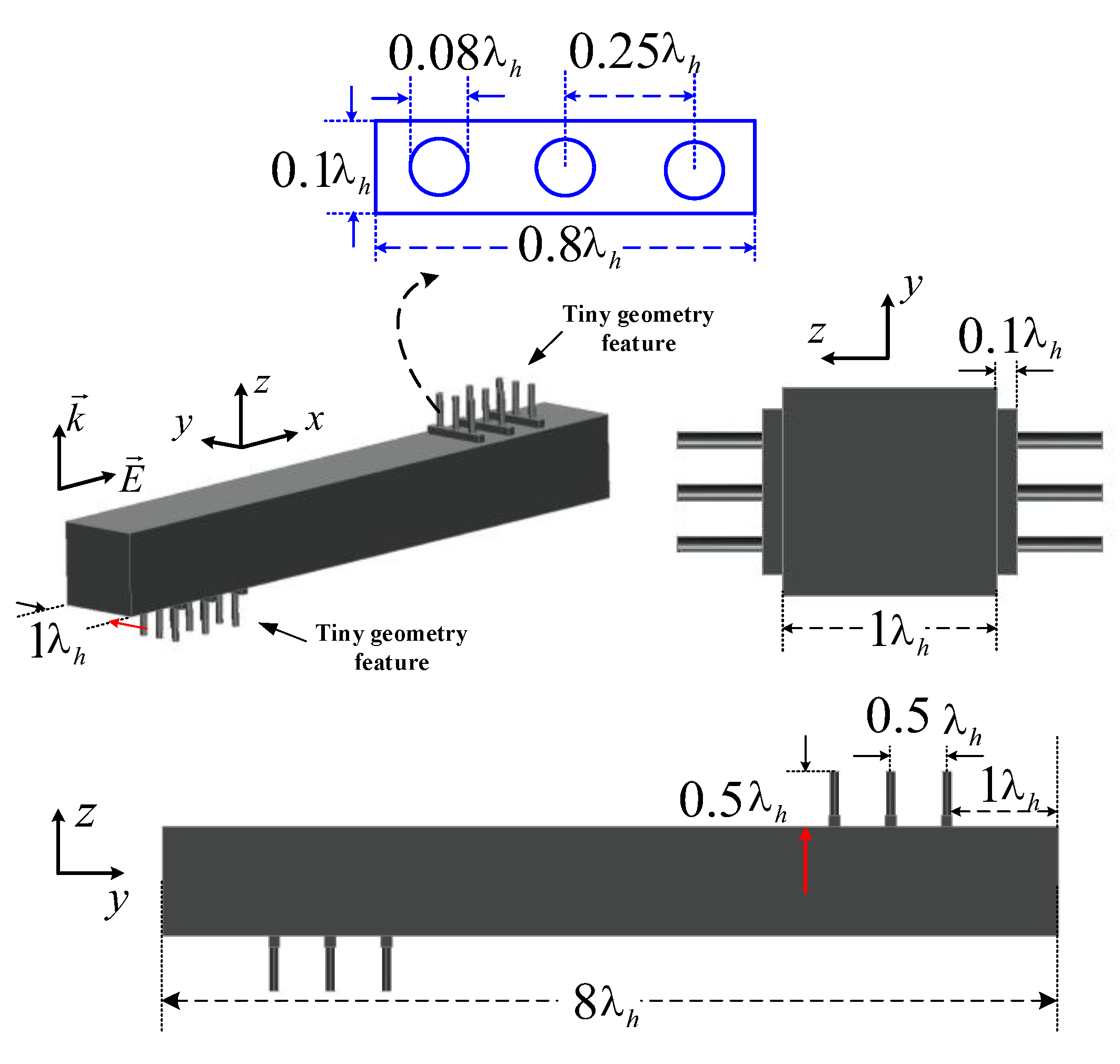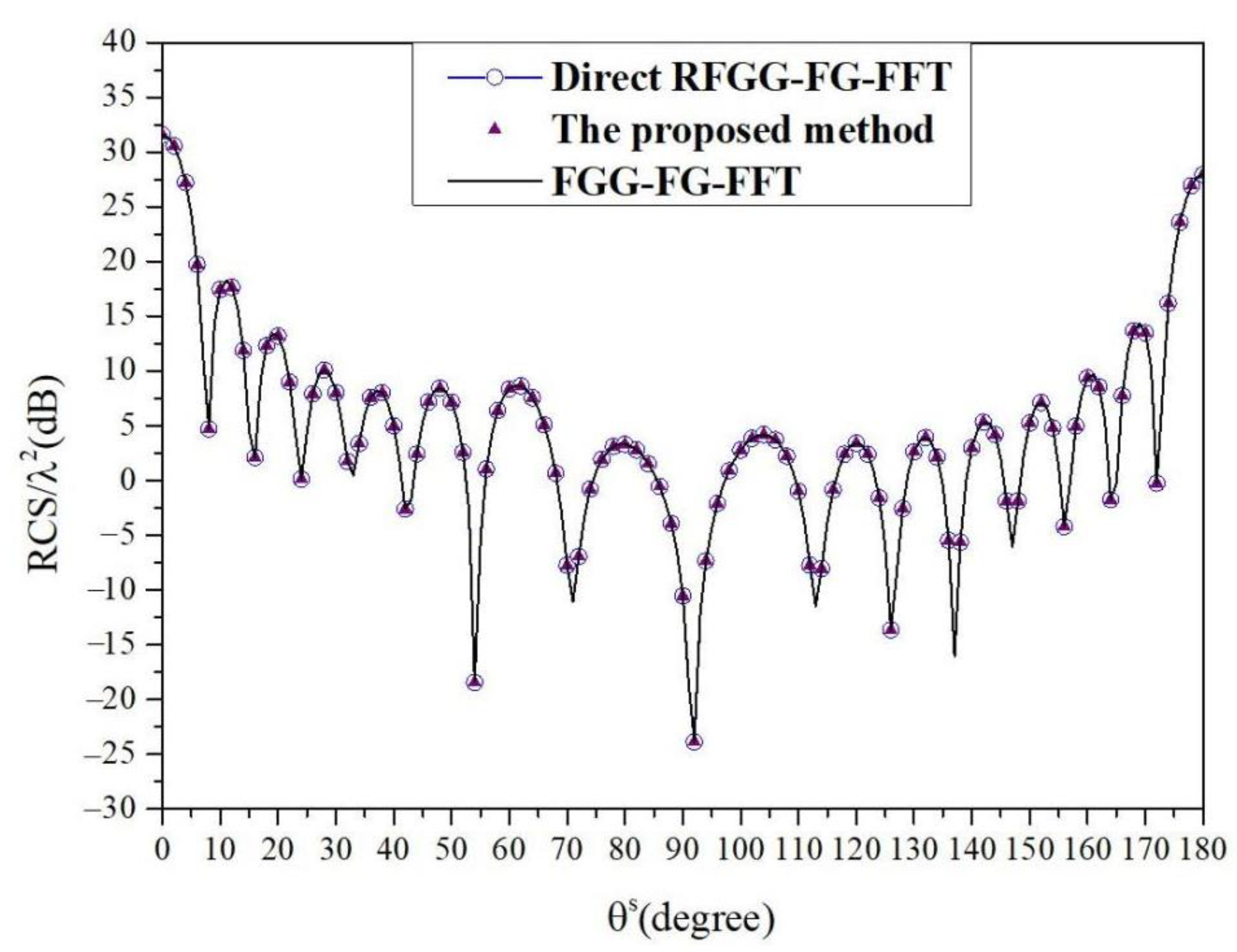Analysis of Wideband Scattering from Antenna Based on RFGG-FG-FFT with Cube Polynomial Inter/Extrapolation Method
Abstract
1. Introduction
2. Method of Moments of Electromagnetic Field
3. Interpolation Technique of MoM Matrix
4. RFGG-FG-FFT Algorithm
5. Numerical Results
5.1. A PEC Cube with Four Monopole Antennas
5.2. A Complex Combination Object of Monopole Antenna Arrays and Cuboid
6. Conclusions
Author Contributions
Funding
Institutional Review Board Statement
Informed Consent Statement
Conflicts of Interest
References
- Harrington, R.F. Field Computation by Moment Methods, 2nd ed.; IEEE Press: New York, NY, USA, 1993. [Google Scholar]
- Zhang, K.; He, M.; Xu, X.W.; Sun, H.J. An efficient solution of the volume-surface integral equation for electromagnetic scattering and radiation of the composite dielectric-conductor objects with reduced number of unknowns. IEEE Trans. Antennas Propag. 2013, 61, 798–808. [Google Scholar] [CrossRef]
- Lei, W.; Shao, H.R.; Hu, J. An efficient integral equation model-order reduction method for complex radiation problem. IEEE Antennas Wireless Propag. Lett. 2021, 20, 1205–1209. [Google Scholar] [CrossRef]
- Dong, H.; Gong, S.; Wang, X.; Zhang, P.; Zhao, B. Efficient analysis of surface-wire configurations using AIM and best uniform rational approximation. Chin. J. Electron. 2015, 4, 215–221. [Google Scholar] [CrossRef]
- Dong, H.; Gong, S.; Xue, H.; Wang, X.; Zhao, B.; Zhang, P. A hybrid broadband analysis approach for surface-wire junctions structures by applying AIM and asymptotic waveform evaluation technique. J. Electromagnet. Wave. 2016, 30, 141–153. [Google Scholar] [CrossRef]
- Li, W.W.; Chen, W.; Fu, Z.J. Precorrected-FFT accelerated singular boundary method for large-scale three-dimensional potential problems. Commun. Comput. Phys. 2017, 22, 460–472. [Google Scholar] [CrossRef]
- Wang, C.F.; Ling, F.; Jin, J.M. A fast full-wave analysis of scattering and radiation from large finite arrays of microstrip antennas. IEEE Trans. Antennas Propag. 1998, 46, 1467–1474. [Google Scholar] [CrossRef]
- Ridene, S. Novel T-shaped GaSb/InAsN quantum wire for mid-infrared laser applications. Phys. Lett. A 2017, 381, 3324–3331. [Google Scholar] [CrossRef]
- Rui, P.L.; Chen, R.S.; Fan, Z.H.; Yung, E.K.N.; Chan, E.C.H.; Nie, Z.P.; Hu, J. Fast analysis of electromagnetic scattering of 3-D dielectric bodies with augmented GMRES-FFT method. IEEE Trans. Antennas Propag. 2005, 53, 3848–3853. [Google Scholar] [CrossRef]
- Sun, H.L.; Tong, C.M. Analysis of scattering from composite conductor and dielectric objects using single integral equation method and FG-FFT. J. Electromagn. Waves Appl. 2017, 31, 225–240. [Google Scholar] [CrossRef]
- Tian, G.L.; Tong, C.M.; Peng, P.; Xie, S.J. Fast RFGG-FG-FFT/IKA for scattering from multiple targets above a rough surface. IEEE Antennas Wirel. Propag. Lett. 2021, 20, 1239–1243. [Google Scholar] [CrossRef]
- Ridene, S. Mid-infrared emission in InxGa1−xAs/GaAs T-shaped quantum wire lasers and its indium composition dependence. Infrared Phys. Technol. 2018, 89, 218–222. [Google Scholar] [CrossRef]
- Darve, E. The fast multipole method: Numerical implementation. J. Comput. Phys. 2000, 160, 195–240. [Google Scholar] [CrossRef]
- Song, J.-M.; Lu, C.-C.; Chew, W.C. Multilevel fast multipole algorithm for electromagnetic scattering by large complex objects. IEEE Trans. Antennas Propag. 1997, 45, 1488–1493. [Google Scholar] [CrossRef]
- Liu, Y.N.; Pan, X.M. Solution of volume-surface integral equation accelerated by MLFMA and skeletonization. IEEE Trans. Antennas Propag. 2022, 70, 6078–6083. [Google Scholar] [CrossRef]
- Bao, Y.; Song, J.M. Multilevel kernel degeneration–adaptive cross approximation method to model eddy current NDE problems. J. Nondestr. Eval. 2022, 41, 17. [Google Scholar] [CrossRef]
- Su, T.; Ding, D.; Fan, Z.; Chen, R. Efficient analysis of EM scattering from bodies of revolution via the ACA. IEEE Trans. Antennas Propag. 2014, 62, 983–985. [Google Scholar] [CrossRef]
- Li, M.; Francavilla, M.A.; Chen, R.S.; Vecchi, G. Wideband fast kernel-independent modeling of large multiscale structures via nested equivalent source approximation. IEEE Trans. Antennas Propag. 2015, 63, 2122–2134. [Google Scholar] [CrossRef]
- Wu, B.; Sheng, X. Application of asymptotic waveform evaluation to hybrid FE-BI-MLFMA for fast RCS computation over a frequency band. IEEE Trans. Antennas Propag. 2013, 61, 2597–2604. [Google Scholar] [CrossRef]
- Pan, X.; Sheng, X. Effificient wide-band evaluation of electromagnetic wave scattering from complex targets. IEEE Trans. Antennas Propag. 2014, 62, 4304–4313. [Google Scholar] [CrossRef]
- Fares, M.; Hesthaven, J.S.; Maday, Y.; Stamm, B. The reduced basis method for the electric field integral equation. J. Comput. Phys. Lett. 2017, 16, 825–828. [Google Scholar] [CrossRef]
- Wu, L.F.; Zhao, Y.W.; Cai, Q.M.; Zhang, R.R.; Gu, L.; Zhang, Z.P.; Nie, Z.P. MLACE-MLFMA combined with reduced basis method for efficient wideband electromagnetic scattering from metallic targets. IEEE Trans. Antennas Propag. 2019, 67, 4738–4747. [Google Scholar] [CrossRef]
- Li, W.D.; Zhou, H.X.; Hu, J.; Song, Z.; Hong, W. Accuracy improvement of cubic polynomial inter/extrapolation of MoM matrices by optimizing frequency samples. IEEE Antennas Wireless Propag. Lett. 2011, 10, 888–891. [Google Scholar]
- Miller, E.K. Adaptive sparse sampling to estimate radiation and scattering patterns to a specifified uncertainty with model-based parameter estimation: Compute patterns using as few as two to four samples per lobe. IEEE Antennas Propag. Mag. 2015, 57, 103–113. [Google Scholar] [CrossRef]
- Jeong, Y.R.; Hong, I.P.; Chun, H.J.; Park, Y.B.; Kim, Y.J.; Yook, J.G. Fast scattering analysis over a wide frequency band using Clenshaw-Lord-type Pade-Chebyshev approximation. IET Microw. Antennas Propag. 2016, 10, 245–250. [Google Scholar] [CrossRef]







| Ex. | Computing Method | ||
|---|---|---|---|
| A PEC Cube with four monopole antennas | Direct RFGG-FG-FFT | 103 | 0.5 |
| The proposed method | 5 | 0.5 | |
| FGG-FG-FFT | 123 | 0.7 | |
| A complex combination object of monopole antenna arrays and cuboid | Direct RFGG-FG-FFT | 2320 | 46 |
| The proposed method | 84 | 44 | |
| FGG-FG-FFT | 2718 | 63 |
Publisher’s Note: MDPI stays neutral with regard to jurisdictional claims in published maps and institutional affiliations. |
© 2022 by the authors. Licensee MDPI, Basel, Switzerland. This article is an open access article distributed under the terms and conditions of the Creative Commons Attribution (CC BY) license (https://creativecommons.org/licenses/by/4.0/).
Share and Cite
Kong, W.; Zheng, Y.; Song, Y.; Fang, Z.; Yang, X.; Zhang, H. Analysis of Wideband Scattering from Antenna Based on RFGG-FG-FFT with Cube Polynomial Inter/Extrapolation Method. Appl. Sci. 2022, 12, 10298. https://doi.org/10.3390/app122010298
Kong W, Zheng Y, Song Y, Fang Z, Yang X, Zhang H. Analysis of Wideband Scattering from Antenna Based on RFGG-FG-FFT with Cube Polynomial Inter/Extrapolation Method. Applied Sciences. 2022; 12(20):10298. https://doi.org/10.3390/app122010298
Chicago/Turabian StyleKong, Weibin, Yongtao Zheng, Yubin Song, Zhongqing Fang, Xiaofang Yang, and Haonan Zhang. 2022. "Analysis of Wideband Scattering from Antenna Based on RFGG-FG-FFT with Cube Polynomial Inter/Extrapolation Method" Applied Sciences 12, no. 20: 10298. https://doi.org/10.3390/app122010298
APA StyleKong, W., Zheng, Y., Song, Y., Fang, Z., Yang, X., & Zhang, H. (2022). Analysis of Wideband Scattering from Antenna Based on RFGG-FG-FFT with Cube Polynomial Inter/Extrapolation Method. Applied Sciences, 12(20), 10298. https://doi.org/10.3390/app122010298




